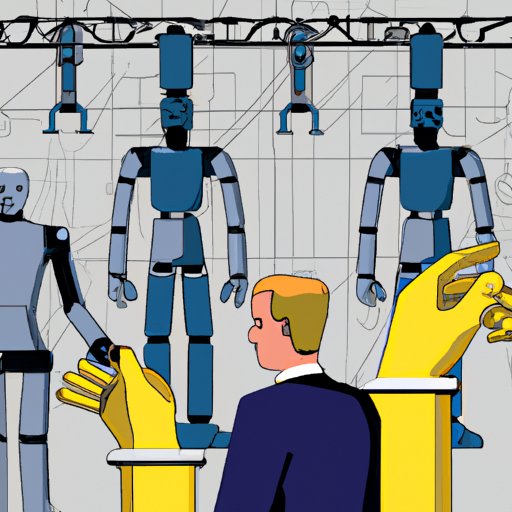Introduction
With advances in technology, automation and robotics are becoming increasingly prevalent in the workplace. Automation refers to the use of machines, computers, and other technologies to perform tasks that would traditionally be done by humans. Robotics is a branch of automation that focuses on the development of robots – humanoid machines that are designed to look and act like humans. As automation and robotics become more commonplace, there is growing concern about their impact on employment and job security.
Examining the Impact of Automation and Robotics on Employment
Proponents of automation and robotics contend that they can improve efficiency, reduce costs, and increase productivity. For example, humanoid robots can be used to assist with customer service, provide medical care, or perform dangerous tasks in hazardous environments. Additionally, the use of robots can help reduce the number of repetitive, mundane tasks that need to be done, freeing up employees to focus on higher-level work.
However, there are also potential drawbacks to using robots in the workplace. Humanoid robots can be expensive to purchase, maintain, and program. They can also be difficult to operate and require specialized training. Additionally, there is the risk that robots may not be able to replicate human interactions or judgment calls, leading to mistakes or miscommunications.
Furthermore, there is the possibility that automation and robotics could lead to job losses. According to a study by the McKinsey Global Institute, up to 375 million workers, or 14 percent of the global workforce, could be displaced by automation and robotics by 2030. This could have a significant impact on the global economy, as these displaced workers will need to find new sources of income.

Investigating the Role of Artificial Intelligence and Its Impact on Jobs
In addition to automation and robotics, artificial intelligence (AI) is also having an impact on employment. AI is a form of computer programming that enables machines to learn and adapt to their environment. AI is being used in a variety of industries, such as healthcare, finance, and transportation. While AI has the potential to improve efficiency and accuracy, it also presents a risk of displacement for certain jobs.
The use of robotics and AI can also have an effect on wages and income inequality. A study by the National Bureau of Economic Research found that the introduction of robots into workplaces led to a reduction in wages for low-skilled workers, while high-skilled workers saw an increase in their wages. This could lead to an increase in income inequality, as those with lower levels of education and skills may struggle to find jobs that pay a living wage.
On the other hand, there are some potential benefits to the use of robots and AI in the workplace. In addition to improving efficiency and accuracy, robots and AI can also help reduce labor costs. Additionally, they can free up employees to focus on tasks that require more complex thinking and problem solving.

Looking at the Future of Work in the Age of Automation
As automation and robotics become more commonplace, it is important to consider the future of work. Some experts predict that the labor market will become increasingly automated, with robots and AI taking over many of the jobs currently done by humans. Others argue that automation and robotics could create new opportunities for work, allowing humans to focus on more creative and innovative tasks.
In order to prepare for the future of work, it is important to develop strategies for adapting to the changing workforce. Workers should consider developing new skills and qualifications in order to stay competitive in the job market. Additionally, governments and businesses should invest in retraining programs to help displaced workers find new sources of income. Finally, companies should prioritize ethical practices when implementing automation and robotics in the workplace.
Conclusion
Automation and robotics are becoming increasingly prevalent in the workplace, raising concerns about their impact on employment and job security. The use of robots and AI can lead to potential job losses and can have an effect on wages and income inequality. To prepare for the future of work, it is important to develop strategies for adapting to the changing workforce, such as retraining programs and investment in new skills and qualifications. Ultimately, it is essential to ensure that automation and robotics are implemented in an ethical and responsible manner.
(Note: Is this article not meeting your expectations? Do you have knowledge or insights to share? Unlock new opportunities and expand your reach by joining our authors team. Click Registration to join us and share your expertise with our readers.)
